The Color of Mars
author: Holger Isenberg,
[email protected]
,
http://mars news.de
The Red Planet, this name has to appear in
every article of the main-stream press on Mars. The same importance play
the little green men in contributions
of renowned daily German papers such as Frankfurter Allgemeine Zeitung or Sueddeutsche Zeitung published on the
Mars meteorite ALH84001.
Without doubt, the planet appears red with the naked eye in
the night sky, whereby our earth viewed from Mars, would appear clearly blue,
due to the 70% water coverage in connection
with refraction of light in the atmosphere. With a reverse relation
of the water land distribution however, rather a brown-green planet
would be to be seen from space.
The color of the atmosphere, caused by Rayleigh Scattering[4] at gas molecules, determines thus only in very small
amount the color of a planet as seen from space and also directly on the surface!
Why then should the Mars sky, as NASA/JPL PR-department spreads it,
should appear red? This coloring is justified if at all, only with the
refraction of light at atmospheric dust.
But such masses of dust in the atmosphere do not prevail over years on a
planet, which has large water-clouds, fog and ground frost,
since water would wash these away after short time.
Astronomers at the Hubble Spacetelescope and amateur-astronomers[8]
are observing, since long time now, white water-clouds and blueish atmosphere.
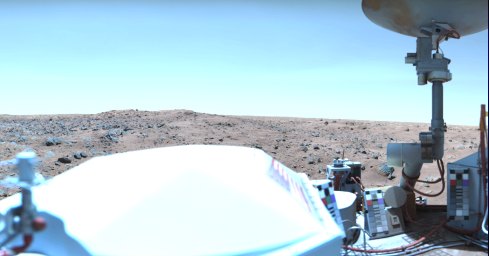
Pic. A, Viking 1, Nr. 12b069, 29. August 1976, 12.65 locale Mars time
This picture was created with color-correction derived from the
filter response data.
(click on picture to view it in original size)
All Viking and Pathfinder images courtesy of JPL/NASA/Caltech.
|

original data without correction
| |
Indeed, when the first color picture from Viking 1 was received on Earth,
the Mars soil was red-brown and the sky was blue, a landscape comparable
with the desert of Arizona[3] (fig. A and B).
These are original pictures[5] of the two probes, which are only slightly color corrected
to match the filter response values of the camera system.
However, the original data without correction, you see on the right of each image,
has almost no detectable difference in color.
The Viking cameras operated according to the principle of a color scanner, whereby for different
light wave lengths different sensors with separate data channels are used.
To create a colorful picture from this scanner data, a color calibration table
is necessary. These tables can be seen near the mast of the
parabolic antenna in Pic. A and B and show among grayscales
the three basic colours (RGB) of a color monitor.
Already with the naked eye it can be detected there that the
colours are correctly shown. Also in Pic.E this can be acknowledged,
since the white ground frost (water ice!) supplies a natural color calibration
to the white alignment.
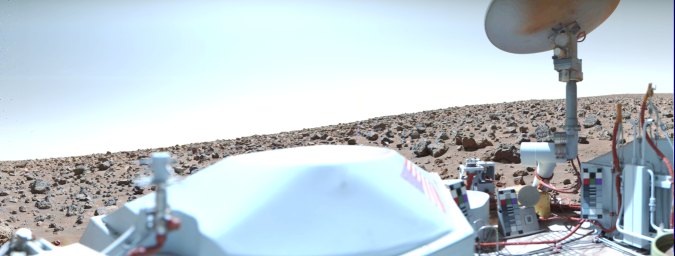
Pic. B, Viking 2, Nr. 22a158, 25. September 1976, 11.96 locale Mars time
This picture was created with color-correction derived from the
filter response data.
|

original data without correction
| |
Pic.C shows a typical (NASA-)red Mars picture in the color,
taken 18 months later. How does it come to this color change,
although the sharply bordered shadows and the otherwise clear
colours suggest no atmosphere dust?
The solution of the mystery appears, when using an
image processing program: By rising the color-values of blue
and green about 50% and 25% one gets to Pic.D, which shows the
well known true coloring from Pic.A and B.
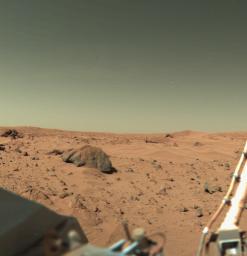
Pic. C, Viking 1, 12h016,
11 February 1978, 15.56
|
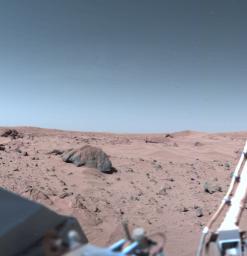
Pic. D
Blue amplified by 50%, green around 25%
|

Pic. E, Viking 2, 21i093,
18.May 1979, 14.24
| |
With the same method[1] we can
get true color picture from Mars Pathfinder (Pic. F and G).
Note, the sharpness of the Pathfinder images is by far not that good
as 20 years ago on Viking as during the Pathfinder mission
an information-reducing picture compression algorithm (comparable to JPEG)
was used.

Pic. F, Pathfinder,
August1997, source:[6]
|
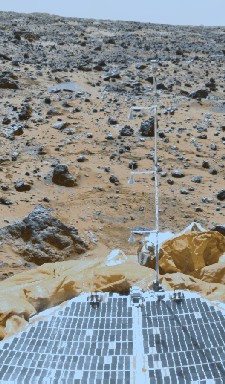
Pic. G,
Blue amplified by approx. 50%,
green by approx. 25%
| |
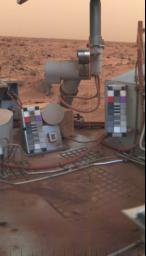
Pic. H, 12e018
03.Jul 1977, 15:20
|
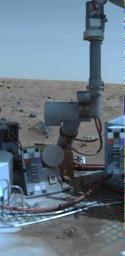
Pic. I, 12b166
6.Oct 1976, 7:48
|
Temporary, the surface illumination is really red, caused by
dust-storms, darkening the sky. The image on the left was taken
shortly after or during such a storm and the diffuse light with almost
no shadows is visible. In contrast to this, the image on the right,
shows sharp shadows and clear blue sky, the normal condition on Mars.
On the image-data of the Viking- and Pathfinder-Missions, this diffuse
illumination is a very rare condition and not the normal state, as NASA seems
to publish it with their dull-red pictures.
|
|
(click on images for unfiltered original data)
|
And now the "official" true color view of the Pathfinder landing site
published by NASA:

Pic. J, Source:
http://mars.jpl.nasa.gov/MPF/science/PDS/pds-jun99.html
Original Caption Released with Image:
The true color of Mars based upon three filters with the sky set to a luminance of 60. The
color of the Pathfinder landing site is yellowish brown with only
subtle variations. These colors are identical to the
measured colors of the Viking landing sites reported by Huck et
al. [1977]. This image was taken near local noon on Sol 10.
A description of the techniques used to generate this color image from
IMP data can be found in Maki et al., 1999. Note: a calibrated
output device is required accurately reproduce the correct
colors.
I don't know why you should calibrate your output device to view this
funny bad-colored picture.
Literature
- [1]
-
Holger Isenberg, Blue Sky on Mars:
http://mars news.de/life
- [2]
-
Robert Shepherd, Synthetic High resolution Viking
image:
http://www.marscentral.com/Places/Landings/Viking/2/
- [3]
-
Vincent DiPietro, Mars: Red sky or blue sky?:
http://www.mufor.org/dipietro3.html,
http://rense.com/general9/color.htm
- [4]
-
Department of Meteorology, University of Maryland, Why is the sky blue?:
http://meto.umd.edu/~ezra/why.html
other sources:
Blue Sky and
Red Sky explained,
"What atmosphere would produce a red sky?"
- [5]
-
NASA/JPL, Planetary Data System Imaging Node:
http://www pdsimage.jpl.nasa.gov/PDS /
- [6]
-
Peter Smith, University of Arizona, Pathfinder panorama:
http://mars.jpl.nasa.gov/MPF/ops/fpress img.html
- [7]
-
Filter spectral responsivities on Viking Lander:
http://mars-news.de/color/filter.html
- [8]
-
Association of Lunar & Planetary Observers: Mars Section:
http://www.lpl.arizona.edu/~rhill/alpo/mars.html











